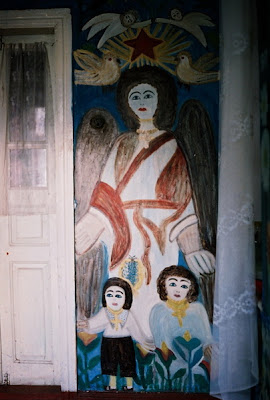I WOULD LIKE TO TELL YOU A STORY about three old women. Their art is an extraordinary sort. And it is by accident that they and their creations have come to light.
I have long been interested in what is generally known as "Outsider Art", "Naïve Art" or "Art Brut" - i.e. art which is made by those not formally trained in any artistic discipline, who mostly do not consider themselves "artists" as such. This isn't an easy genre to define by its very liminal nature, but the creators of it fascinate me. They are the marginal folk, the mad ones, seers of the Other Place, and their work often has a folk art quality to it which enchants me. Paintings and objects are frequently made with discarded things or drawn straight onto the edges of their surroundings: walls, doors, pavements.
So it is with these old women. They paint the walls of their houses. And the paintings are not demure tasteful interior design by any stretch! The walls and ceilings and doors are covered with bright bold "primitive" imagery, strange and wonderful. There are flowers, wolves, cats, angels and demons. There are peasant, religious, bucolic and mythical scenes. Often this urge to make imagery on their house walls bursts from these women later in life, after many hard years in poverty, or following the death of family members.
First we have Enni Id (1900-1992) who lived in the community of Padasjoki in Finland. Her painting career began with widowhood. She covered the walls of her cabin with brightly coloured floral motifs, cats and plants. And she painted canvases too - with angels. Some of these paintings were exhibited in Helsinki, and nowadays her painted cabin can be visited at weekends. Below are panoramic views of her cabin interior which you can mouse-pan to look around. (QuickTime required)
Photo: still from La Sérénité sans carburant - Un film de Marie Famulicki



A film has been made about her by french filmmaker Marie Famulicki titled "Serenity with no Fuel", which I would be fascinated to get hold of.
Third is Polina Raïko (born 1928 as Pelageya Andreyevna; died 2004), from Tsyuryupinsk, in the dusty, remote Kherson region of the Ukraine, not far from the Black Sea coast.

Polina's painting began after a hard and painful period in her life. In 1994, she lost her daughter Olena, and within a year her husband Mykola was dead too. Then in 1998 her son Serhiy, who was a violent alchoholic, was taken to prison, and it was only then (when she was 69) that her first wall paintings began. Serhiy died in 2002, and his mother's painting continued.







Flowers began to grow from the windowsills, mythological beasts roamed the edges of rooms, primordial forests grew beside kitchen cupboards. Babushka-Polina's strange enchanting figures, animals and scenes covered the walls throughout her house. Her colours are bright, and the paintings have overwhelming presence. As Nataliya Kosmolinska says, it is as if these things were born new from the Yaytse-Raytse (the Ukrainian Mythic Egg from which all things are born).
Polina used ordinary house paint, and for inspiration she took images from water bottles, chocolate, wine labels, religious postcards and translated them onto her house walls. In all she painted thirty-six walls, nine ceilings, and some of the courtyard.














 All photos above and below from English Russia and Kolya-S-Raena
All photos above and below from English Russia and Kolya-S-RaenaIn the last years of her life, Polina's creations were discovered by tourists and there followed visits from journalists, artists, film directors and many others. Communist ideology creeps into her work in places: hammer and sickle, a female Soviet Army captain and a "military medic". But much of her imagery was religious in nature, with churches, saints, winged figures and heavenly birds appearing regularly. After Polina's death on January 15th 2004, a painted phrase was found on the garage door: "How to find a way to paradise..."
The house was inherited by Polina's grandson who was utterly unappreciative of her work, and saw nothing in his grandmother's strange paintings. He put it up for sale for $6000 and it was bought by an American couple living in the Ukraine. It is inhabited now by Nadia, a relative of Polina's, who sees herself as a kind of museum curator. Sadly the paintings were made directly onto the plaster and so with the passing of time and damp, the paint is peeling away in places...

There seems to be a spiritual element to the work too, it is a kind of mantra, the repeated designs and complete covering of all surfaces appear like a constant and dedicated prayer. And the beauty of the work must not be forgotten either: to make your surroundings so colourful and decorative and replete with symbolic imagery is a magnificent and powerful thing. Entering these houses must feel quite wonderful.
For me there's a delicious juxtaposition between the sacred and the profane here: Polina Raïko longed to paint a church, but could not until she found an image on a wine bottle label for reference. And the eagerness and obsessiveness with which these women painted belies some seeming sacred purpose, written out on the edge-place of the ordinary.
I leave you with a quote from Jean Dubuffet who defined Art Brut thus:
~ Jean Dubuffet. Place à l'incivisme (Make way for Incivism).
Art and Text no.27 (December 1987 - February 1988). p.36
* * * * * * * * * * * * * *
If you are interested in seeing and reading more about Outsider Art, I can highly recommend Raw Vision Magazine.
And thanks for information and photo credits go to these sites:
Outsider Environments Europe
Animula Vagula
(both of the above also recommended for Outsider Art enthusiasts)
English Russia
Oleksiy Kachmar
Laatuaika
Kolya-S-Raena
Nataliya Kosmolinska
Totem, Kherson


























































